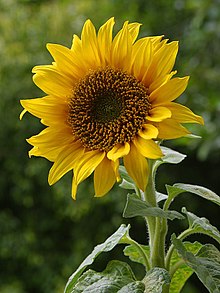Our website is made possible by displaying online advertisements to our visitors.
Please consider supporting us by disabling your ad blocker.
Asterales
This article includes a list of general references, but it lacks sufficient corresponding inline citations. (February 2012) |
| Asterales | |
|---|---|

| |
| Sunflower, Helianthus annuus | |
| Scientific classification | |
| Kingdom: | Plantae |
| Clade: | Tracheophytes |
| Clade: | Angiosperms |
| Clade: | Eudicots |
| Clade: | Asterids |
| Clade: | Campanulids |
| Order: | Asterales Link[1] |
| Families | |
| |
Asterales (/ˌæstəˈreɪliːz/ ASS-tər-RAY-leez)[2] is an order of dicotyledonous flowering plants that includes the large family Asteraceae (or Compositae) known for composite flowers made of florets, and ten families related to the Asteraceae.[3] While asterids in general are characterized by fused petals, composite flowers consisting of many florets create the false appearance of separate petals (as found in the rosids).
The order is cosmopolitan (plants found throughout most of the world including desert and frigid zones), and includes mostly herbaceous species, although a small number of trees (such as the Lobelia deckenii, the giant lobelia, and Dendrosenecio, giant groundsels) and shrubs are also present.
Asterales are organisms that seem to have evolved from one common ancestor. Asterales share characteristics on morphological and biochemical levels. Synapomorphies (a character that is shared by two or more groups through evolutionary development) include the presence in the plants of oligosaccharide inulin, a nutrient storage molecule used instead of starch; and unique stamen morphology. The stamens are usually found around the style, either aggregated densely or fused into a tube, probably an adaptation in association with the plunger (brush; or secondary) pollination that is common among the families of the order, wherein pollen is collected and stored on the length of the pistil.
- ^ Angiosperm Phylogeny Group (2009). "An update of the Angiosperm Phylogeny Group classification for the orders and families of flowering plants: APG III". Botanical Journal of the Linnean Society. 161 (2): 105–121. doi:10.1111/j.1095-8339.2009.00996.x. hdl:10654/18083.
- ^ Stearn, William Thomas (2004). Botanical Latin. Timber Press. ISBN 978-0-88192-627-9. Retrieved 14 April 2020.
- ^ Kubitzki, K. (1990). The Families and Genera of Vascular Plants: Flowering Plants, Eudicots: Asterales. Springer. Retrieved 14 April 2020.
Previous Page Next Page


